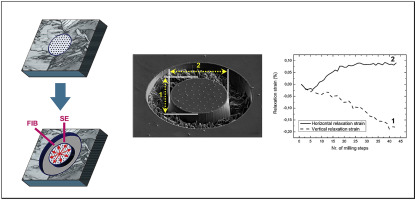当前位置:
X-MOL 学术
›
Acta Mater.
›
论文详情
Our official English website, www.x-mol.net, welcomes your
feedback! (Note: you will need to create a separate account there.)
Anisotropic distribution of the micro residual stresses in lath martensite revealed by FIB ring-core milling technique
Acta Materialia ( IF 8.3 ) Pub Date : 2018-05-01 , DOI: 10.1016/j.actamat.2018.03.030 Fady Archie , Muhammad Zeeshan Mughal , Marco Sebastiani , Edoardo Bemporad , Stefan Zaefferer
Acta Materialia ( IF 8.3 ) Pub Date : 2018-05-01 , DOI: 10.1016/j.actamat.2018.03.030 Fady Archie , Muhammad Zeeshan Mughal , Marco Sebastiani , Edoardo Bemporad , Stefan Zaefferer

|
Abstract Lath martensite structures in medium-carbon steels incorporate a significant amount of residual stresses that are mostly induced by the martensitic transformation process. Although former studies could identify these stresses using diffraction techniques, it was not possible to correlate the micro-scale distribution of the stress fields with respect to the morphological and the crystallographic parameters of the martensitic structure. In this study, we employ the micro-scale focused ion beam (FIB) ring-core milling technique for the measurement of local residual strain and stress distributions in fully martensitic microstructures. The aim is to study the residual stresses occurring within individual lath martensite crystals, and within areas of lath martensite which incorporate a parent austenite grain boundary. The relaxation strains obtained by the micrometer-sized ring-core milling, which correspond to the residual stresses prior to milling, are shown to exhibit an anisotropic distribution for each martensite variant. High extension relaxation strains (i.e. compressive stresses) prevail in the direction of the transformation-induced crystal shape deformation direction. Contraction strains (i.e. tensile residual stresses) are measured normal to the extension strains. In an area containing a prior austenite grain boundary, the residual stresses appeared – altogether – lower than in single crystal martensite laths. The significant residual tensile stresses identified in the martensite structures may support the formation of martensite micro-cracks, either in the as-quenched state or during deformation.
中文翻译:

FIB环芯铣削技术揭示板条马氏体微观残余应力各向异性分布
摘要 中碳钢中的板条马氏体组织包含大量残余应力,这些残余应力主要是由马氏体转变过程引起的。虽然以前的研究可以使用衍射技术识别这些应力,但不可能将应力场的微观分布与马氏体结构的形态和晶体参数相关联。在这项研究中,我们采用微尺度聚焦离子束 (FIB) 环芯铣削技术测量完全马氏体显微组织中的局部残余应变和应力分布。目的是研究在单个板条马氏体晶体内以及在包含母体奥氏体晶界的板条马氏体区域内发生的残余应力。通过微米级环芯铣削获得的松弛应变与铣削前的残余应力相对应,显示出每个马氏体变体的各向异性分布。高拉伸松弛应变(即压缩应力)在转变引起的晶体形状变形方向上占优势。收缩应变(即拉伸残余应力)是垂直于拉伸应变测量的。在包含原始奥氏体晶界的区域中,残余应力出现 - 总而言 - 低于单晶马氏体板条。在马氏体结构中确定的显着残余拉应力可能支持马氏体微裂纹的形成,无论是在淬火状态还是在变形过程中。与铣削前的残余应力相对应,显示出每种马氏体变体的各向异性分布。高拉伸松弛应变(即压缩应力)在转变引起的晶体形状变形方向上占优势。收缩应变(即拉伸残余应力)是垂直于拉伸应变测量的。在包含原始奥氏体晶界的区域中,残余应力出现 - 总而言 - 低于单晶马氏体板条。在马氏体结构中确定的显着残余拉应力可能支持马氏体微裂纹的形成,无论是在淬火状态还是在变形过程中。与铣削前的残余应力相对应,显示出每种马氏体变体的各向异性分布。高拉伸松弛应变(即压缩应力)在转变引起的晶体形状变形方向上占优势。收缩应变(即拉伸残余应力)是垂直于拉伸应变测量的。在包含原始奥氏体晶界的区域中,残余应力出现 - 总而言 - 低于单晶马氏体板条。在马氏体结构中确定的显着残余拉应力可能支持马氏体微裂纹的形成,无论是在淬火状态还是在变形过程中。显示出每个马氏体变体的各向异性分布。高拉伸松弛应变(即压缩应力)在转变引起的晶体形状变形方向上占优势。收缩应变(即拉伸残余应力)是垂直于拉伸应变测量的。在包含原始奥氏体晶界的区域中,残余应力出现 - 总而言 - 低于单晶马氏体板条。在马氏体结构中确定的显着残余拉应力可能支持马氏体微裂纹的形成,无论是在淬火状态还是在变形过程中。显示出每个马氏体变体的各向异性分布。高拉伸松弛应变(即压缩应力)在转变引起的晶体形状变形方向上占优势。收缩应变(即拉伸残余应力)是垂直于拉伸应变测量的。在包含原始奥氏体晶界的区域中,残余应力出现 - 总而言 - 低于单晶马氏体板条。在马氏体结构中确定的显着残余拉应力可能支持马氏体微裂纹的形成,无论是在淬火状态还是在变形过程中。拉伸残余应力)垂直于拉伸应变测量。在包含原始奥氏体晶界的区域中,残余应力出现 - 总而言 - 低于单晶马氏体板条。在马氏体结构中确定的显着残余拉应力可能支持马氏体微裂纹的形成,无论是在淬火状态还是在变形过程中。拉伸残余应力)垂直于拉伸应变测量。在包含原始奥氏体晶界的区域中,残余应力出现 - 总而言 - 低于单晶马氏体板条。在马氏体结构中确定的显着残余拉应力可能支持马氏体微裂纹的形成,无论是在淬火状态还是在变形过程中。
更新日期:2018-05-01
中文翻译:

FIB环芯铣削技术揭示板条马氏体微观残余应力各向异性分布
摘要 中碳钢中的板条马氏体组织包含大量残余应力,这些残余应力主要是由马氏体转变过程引起的。虽然以前的研究可以使用衍射技术识别这些应力,但不可能将应力场的微观分布与马氏体结构的形态和晶体参数相关联。在这项研究中,我们采用微尺度聚焦离子束 (FIB) 环芯铣削技术测量完全马氏体显微组织中的局部残余应变和应力分布。目的是研究在单个板条马氏体晶体内以及在包含母体奥氏体晶界的板条马氏体区域内发生的残余应力。通过微米级环芯铣削获得的松弛应变与铣削前的残余应力相对应,显示出每个马氏体变体的各向异性分布。高拉伸松弛应变(即压缩应力)在转变引起的晶体形状变形方向上占优势。收缩应变(即拉伸残余应力)是垂直于拉伸应变测量的。在包含原始奥氏体晶界的区域中,残余应力出现 - 总而言 - 低于单晶马氏体板条。在马氏体结构中确定的显着残余拉应力可能支持马氏体微裂纹的形成,无论是在淬火状态还是在变形过程中。与铣削前的残余应力相对应,显示出每种马氏体变体的各向异性分布。高拉伸松弛应变(即压缩应力)在转变引起的晶体形状变形方向上占优势。收缩应变(即拉伸残余应力)是垂直于拉伸应变测量的。在包含原始奥氏体晶界的区域中,残余应力出现 - 总而言 - 低于单晶马氏体板条。在马氏体结构中确定的显着残余拉应力可能支持马氏体微裂纹的形成,无论是在淬火状态还是在变形过程中。与铣削前的残余应力相对应,显示出每种马氏体变体的各向异性分布。高拉伸松弛应变(即压缩应力)在转变引起的晶体形状变形方向上占优势。收缩应变(即拉伸残余应力)是垂直于拉伸应变测量的。在包含原始奥氏体晶界的区域中,残余应力出现 - 总而言 - 低于单晶马氏体板条。在马氏体结构中确定的显着残余拉应力可能支持马氏体微裂纹的形成,无论是在淬火状态还是在变形过程中。显示出每个马氏体变体的各向异性分布。高拉伸松弛应变(即压缩应力)在转变引起的晶体形状变形方向上占优势。收缩应变(即拉伸残余应力)是垂直于拉伸应变测量的。在包含原始奥氏体晶界的区域中,残余应力出现 - 总而言 - 低于单晶马氏体板条。在马氏体结构中确定的显着残余拉应力可能支持马氏体微裂纹的形成,无论是在淬火状态还是在变形过程中。显示出每个马氏体变体的各向异性分布。高拉伸松弛应变(即压缩应力)在转变引起的晶体形状变形方向上占优势。收缩应变(即拉伸残余应力)是垂直于拉伸应变测量的。在包含原始奥氏体晶界的区域中,残余应力出现 - 总而言 - 低于单晶马氏体板条。在马氏体结构中确定的显着残余拉应力可能支持马氏体微裂纹的形成,无论是在淬火状态还是在变形过程中。拉伸残余应力)垂直于拉伸应变测量。在包含原始奥氏体晶界的区域中,残余应力出现 - 总而言 - 低于单晶马氏体板条。在马氏体结构中确定的显着残余拉应力可能支持马氏体微裂纹的形成,无论是在淬火状态还是在变形过程中。拉伸残余应力)垂直于拉伸应变测量。在包含原始奥氏体晶界的区域中,残余应力出现 - 总而言 - 低于单晶马氏体板条。在马氏体结构中确定的显着残余拉应力可能支持马氏体微裂纹的形成,无论是在淬火状态还是在变形过程中。










































 京公网安备 11010802027423号
京公网安备 11010802027423号